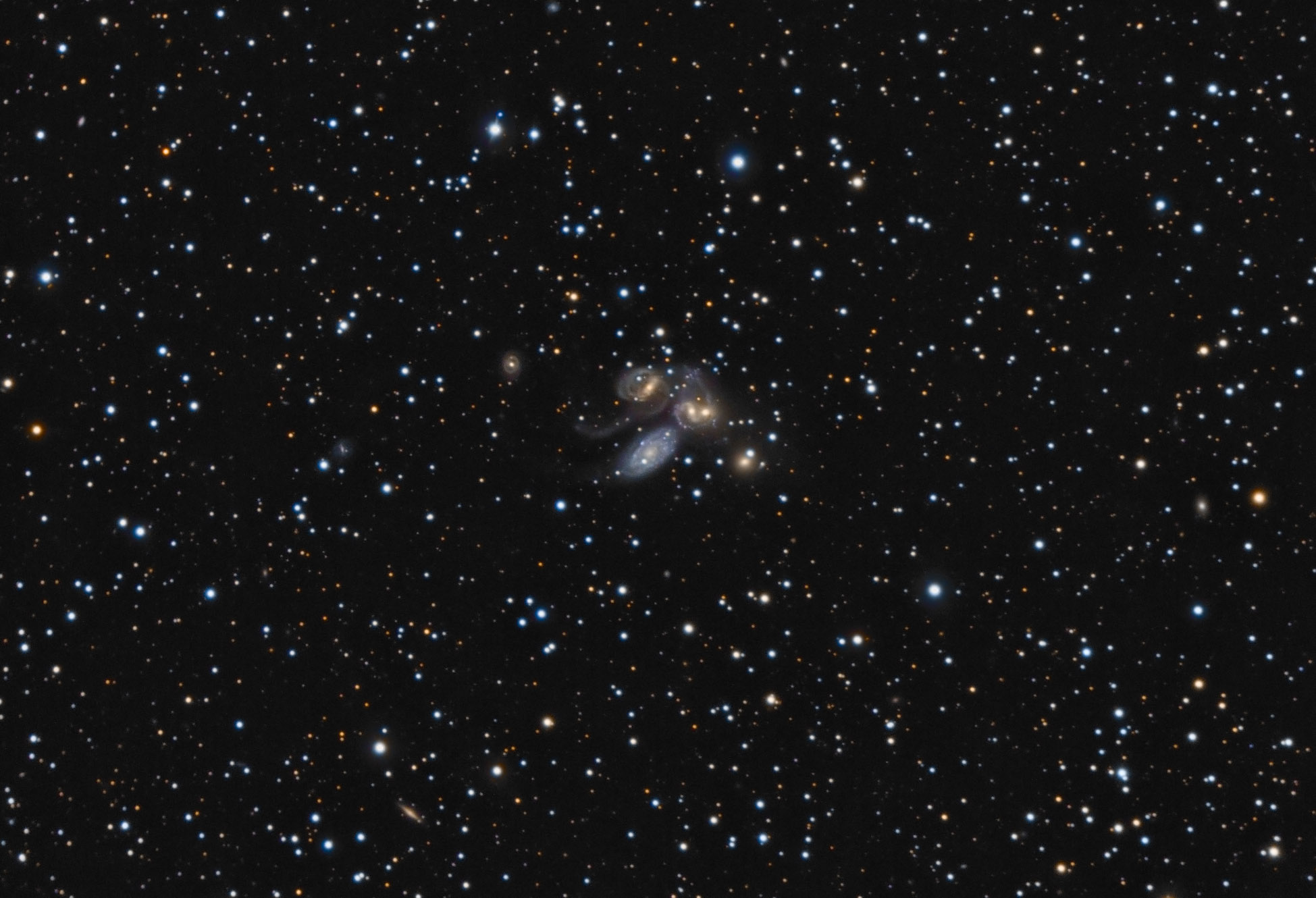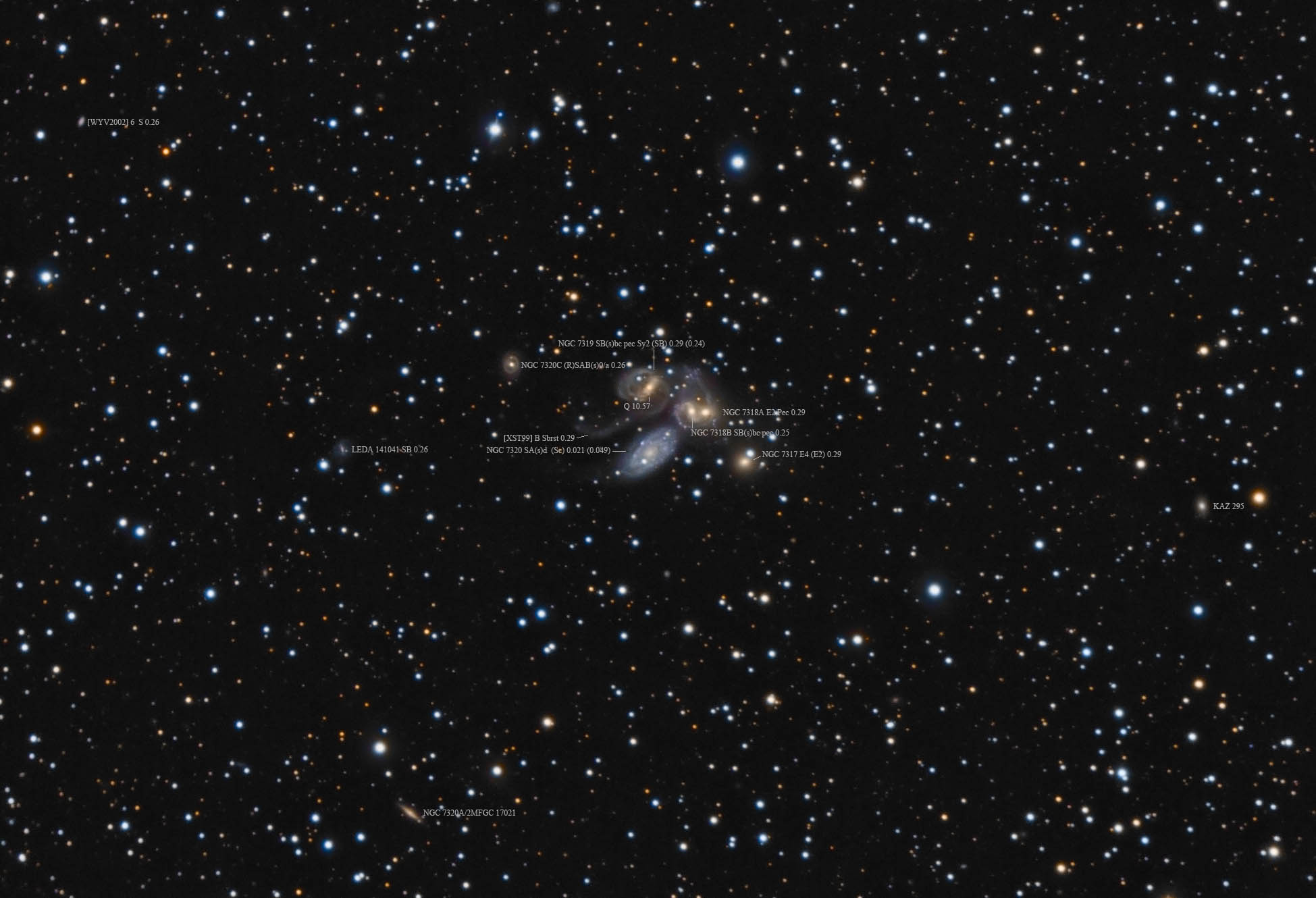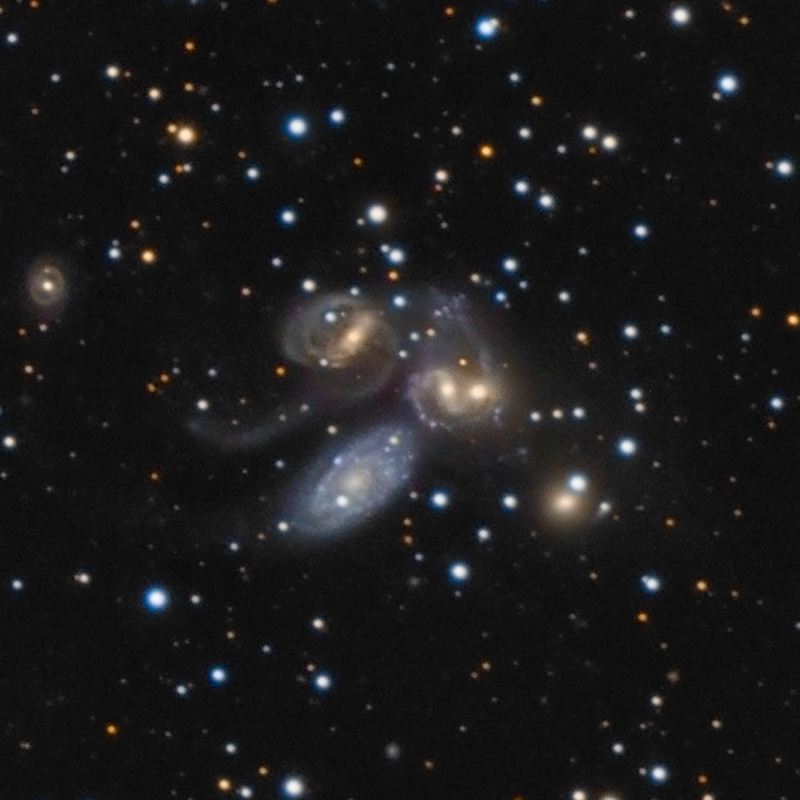| Description | Images |
Object name: ARP319Designation(s): ARP319, NGC7317, NGC7318, NGC7320, NGC7319, NGC7320, Arp 319 is better known as Stephan's Quintet. It is really a group of 4 galaxies with a 5th galaxy in the foreground though there is a true fifth member Arp didn't include it. The interloper galaxy is NGC 7320. It is apparently the largest of the group and the bluest. It is really a member of the so-called "Deer Lick" group located less than a degree away. It is located only some 40 million light-years away while the other 4 are about 270 million light-years from us. At one time this group was put forth by some to disprove redshift as a distance measure to the universe. Since NGC 7320 is close it has a small redshift while the other 4 have a large redshift. But if all were at the same distance then redshift was called into question. It took Hubble to answer this for sure. It could resolve stars in NGC 7320 but only massive star clusters in the others. This was consistent with the redshift distances and it is now accepted that 7320 is a Deer Lick member seen in front of the far more distant group. Actually, we do have 5 members of this distant group. To the left, a bit is a barred spiral whose arms make a nice ring, NGC 7320C. It is now known to be a member of the group and may be responsible for some of the tidal plumes. So there really are 5 galaxies in Stephan's quintet, just that one isn't the one we thought was a member for many years. Related Designation(s):1AXG J223603+3358, 1RXH J223603.2+335833, 2MASS J22355187+3356417, 2MASX J22355187+3356415, 2MASX J22360337+3356531, 2MASX J22360355+3358327, 2PBC J2236.0+3358, 2XMM J223551.9+335642, 2XMM J223603.4+335651, 2XMM J223603.5+335833, 2XMMp J223552.0+335642, 2XMMp J223603.4+335651, 2XMMp J223603.5+335833, 87GB 223340.5+334218, ARP 319, ARP 319 NED01, ARP 319 NED04, ARP 319 NED05, ARP319, CGCG 2233.6+3341, CGCG 2233.7+3343, CGCG 2233.8+3341, CGCG 2233.8+3343, CGCG 514-060, CGCG 514-061, CGCG 514-062, CGCG 514-063, CGCG 514-064, CXO J223603.59+335833.0, CXOMP J223551.7+335641, CXOMP J223603.3+335653, CXOMP J223603.6+335833, CXOU J223603.6+335833, HCG 092, HCG 092:[KAG2014] 40170, HCG 092:[KAG2014] 40190, HCG 092A, HCG 092C, HCG 092E, HDCE 1198 NED002, HDCE 1198 NED004, HOLM 792, HOLM 792A, HOLM 792B, HOLM 792D, IRAS 22337+3342, IRAS F22337+3342, LDCE 1520 NED051, LDCE 1520 NED053, LGG 459:[G93] 002, LQAC 339+033 001, MAPS-PP E_0778_0772423, MAPS-PP O_0778_1039806, MCG +06-49-038, MCG +06-49-041, MCG +06-49-042, NGC 7317, NGC 7318, NGC 7318B:[L2011a] X0001, NGC 7319, NGC 7319:[L2011a] X0001, NGC 7320, NGC7317, NGC7318, NGC7319, NGC7320, NPM1G +33.0466, NSA 149935, NSA 149941, PBC J2236.0+3358, PGC 069256, PGC 069269, PGC 069270, RSCG 82, RX J2236.0+3358, SDSS J223603.57+335833.0, SSTSL2 J223551.88+335641.7, SWIFT J2235.9+3358, SWIFT J2236.1+3357, UGC 12100 NOTES01, UGC 12101, UGC 12102, USGC U816 NED01, USGC U816 NED03, USGC U818 NED03, UZC J223551.9+335641, UZC J223603.4+335654, UZC J223603.7+335835, UZC-CG 279 NED01, VV 288, VV 288a, VV 288b, VV 288d, WBL 683, WBL 683-001, WBL 683-002, WBL 683-004, WBL 683-005, [dML87] 725, [TCW2007] 190, [TSB2003] 08, [VCV2001] J223603.5+335833, [VCV2006] J223603.5+335833, [WGB2006] 223336+33410_d, [WMR2009] 148, | Permanent link: https://images.mantrapskies.com/catalog/ARP-GALAXIES/ARP319-NGC7317-NGC7318-NGC7320-NGC7319-NGC7320/ARP319L6X10RGB2X10X3R.JPG |


